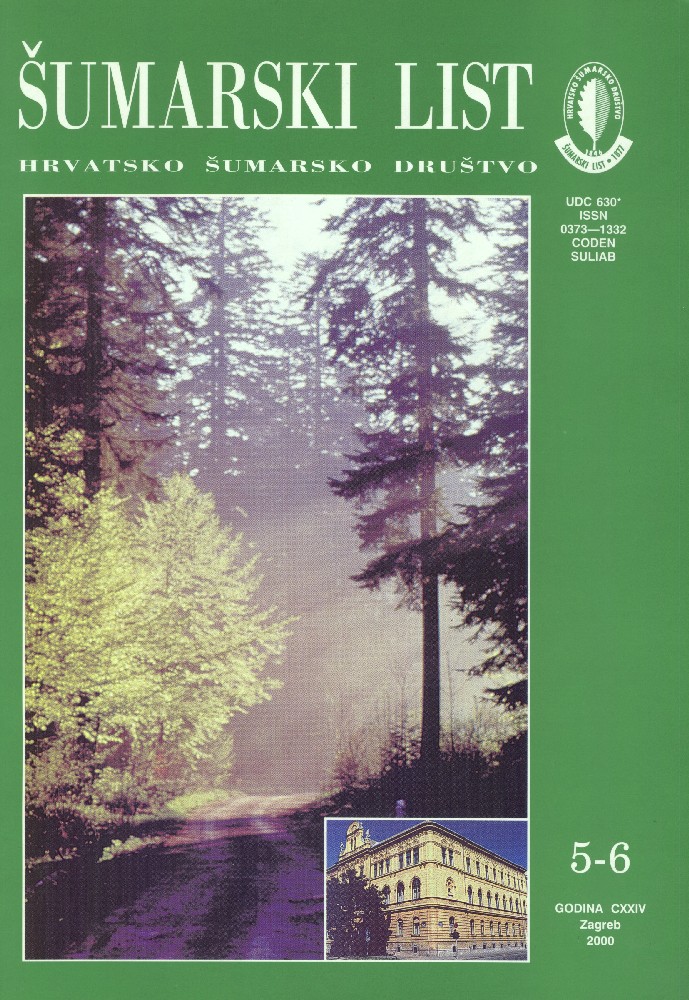
broj: 5-6/2000
pdf (28,1 MB) |
|
||||||||||||||
| IZVORNI ZNANSTVENI ČLANCI | ||
| Idžojtić, M. | UDK 630* 160 (Pinus sp.) 001. | |
| Composition of Volatiles from Needles of Pinus sylvestris L., P. nigra Arnold, P. densiflora Sieb. et Zucc. and P. thunbergiana Franco pdf HR EN | 263 | |
| Ballian, D. | UDK 630* 165 + 232.3 (Prunus avium L.) 001. | |
| First Study on the Variability of Morphological Characteristics of Wild Cherry (Prunus avium L.) Seeds pdf HR EN | 271 | |
| Cvjetan, S., Kajba, D., Pavičić, N., Pejić, I. | UDK 630* 165 (Cupressus sempervirens L.) 001. | |
| Genetic Analysis of the Old Cypress of Hvar (Cupressus sempervirens var. horizontalis (Mill.) Gord. pdf HR EN | 279 | |
| Krapinec, K., Vukelić, J., Grubešić, M. | UDK 630* 451 + 156 (001) | |
| A Contribution to Insights Into Crack Phillyrea (Phyllirea latifolia L.) Browsing by Wild Ruminants on the Island of Rab pdf HR EN | 285 | |
| PREGLEDNI ČLANCI | ||
| Sabadi, R. | UDK 630* 904 | |
| France: Forests of the Overseas Departments pdf HR EN | 293 | |
| Summary: The French National Forestry Service, ONF, which manages public forests, is subdivided into 25 Regional forestry directions, 21 of which are i metropolitan France covering 95 departments (inclusive two at the island of Corsica) with a total forest area of 3.81 million ha. From 1946 four overseas departments have been created: French Guiana, Réunion (in the archipelago of Mascareignes close to the island of Madagascar, eastwardly from Africa, in the Indian Ocean), and Martinique and Guadeloupe (in the arhipelago of Lesser Antilles, dividing Atlantic Ocean from Carribean Sea).The insular departments are under forests more by the fact that area which remained after successive agricultural planting during two centuries has become treeless absolute forest soil, or small dispersed patches of former autochtoneous forests in unapproachable mountain steep slopes and ravines. French Guiana however, is covered by forests more than 90% by tropis evergreen rain forests, the greatest part of which untouched. In both cases the management is in hands of an European industrially developed country, which is an unique example in the world. ONF tries to re-establish the forest cover in islands, with the aim of protection, to fight erosion, floods, and regulation of water resources. The commercial importance of these artificial forests is for the time being mediocre, it will probably remain so, particularly due to the fact that these insular departments are overpopulated. The efforts of ONF in Guiana aims to open about a quarter ot the territory, 80-90% of which would be managed with the aim of ensuring the natural regeneration of desirable commercial tree species, by gradual killing of unwanted ones, maintaining forests close to nature. Over said area about 10-20% of forests should remain unexploited. Forests are distributed in areas of about 10,000 hectares, subdivided into lots comprising 200-300 hectares with keeping strict records of all operations performed over particular time and area. At the same time a network of forest roads is being built. Former cutting permits, after the expiration are not renoveled, the new ones are issued, following plan of envisaged sylvicultural treatments over the concession area. It is to be expected that management of tropical rain forests in French Guiana, with valuable experience collected, will be wellcomed by saving huge areas of such forests in the aequatorial part of South America. The French Guiana will probably not become an attractive settling destination, due to unhealthy climate, but based on huge quantities of nice and valuable timber, besides minerals (e.g. gold mines in the center of the country), it will enable a high livind standard to its population, which is growing despite of climatic and health inconveniences. Key words: Economic development; Joinery and Cabinet making; Logging; management of; Sawmilling; Tropical rain forests | ||
| Gračan, J. | UDK 630* 425 | |
| Trends in Impacts of Long-Range Transboundary Air Pollution pdf HR EN | 303 | |


